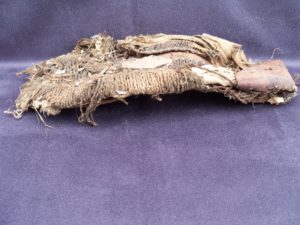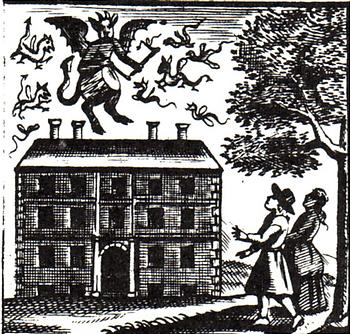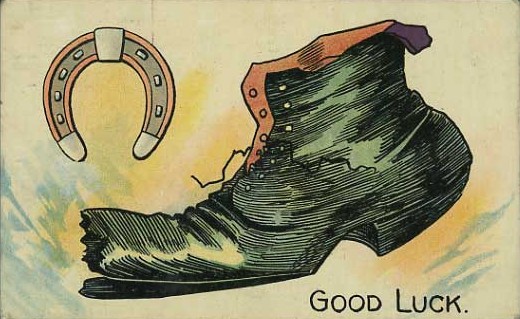Featured Fragment – Salubria’s Hidden Shoe
By M. Chris Manning

Slipper recovered by Dovetail from the attic at Salubria, a mid-eighteenth century Georgian home in Culpeper County, Virginia.
The slipper shown to the left was recovered from an ‘excavation’ in the attic at Salubria, a mid-eighteenth-century Georgian home in Culpeper County, Virginia. This shoe is believed to have been purposefully placed or concealed within the eaves during a mid-nineteenth-century renovation of the roof. The shoe dates to the early nineteenth century and is composed of woven wool with a leather backing and leather sole. Linen lined at least a portion of the shoe, although it is difficult to tell if the entire piece had a lining. Natural wear and a high degree of rodent activity have compromised much of the interior of the shoe.
In the United States, more than 250 cases of concealed shoes have been reported, almost all of which have been described as “old” or “worn,” like the shoe found at Salubria. Fireplaces, hearths, and chimneys are the most common location for concealed shoes, followed by ceilings and subfloor spaces, inside walls, and in attics and roof cavities. The majority of deposits consist of a single shoe or boot, but “families” of several unmatched shoes are also common. Statistically, a little less than half of the examples reported in the U.S. consist of children’s shoes (46 percent), and there is a fairly even distribution among the adult men’s and women’s shoes.
Several theories for shoe concealment have been proposed: a builder’s tradition, a fertility charm, a method for attracting beneficial household spirits, a means of repelling harmful spirits, witches, and demons from entering a building, and as a general good luck charm. In British and Irish folklore, shoes and clothing were believed to both attract and repel supernatural household spirits. These helpful spirits came out at night to lend a hand around the house and farm, often doing the more tedious work while the family slept. In addition to doing odd jobs, many of these spirits also acted as protectors of the family, the home, and the livestock. Although generally benign and helpful, domestic spirits had a capricious streak and liked to play pranks on members of the household. Gifts of shoes and clothes were frequently offered to placate the domestic spirits; however, for some unknown reason, some were inexplicably repelled by offerings of clothing. Numerous tales of both helpful and mischievous spirits being “laid” with a gift of clothes can be found throughout the British Isles. One literary adaptation of this belief was famously conveyed through the popular book series Harry Potter, in which Dobby the house elf is freed by the gift of an old sock.
In addition to attracting and repelling household spirits, concealed shoes may also have been used to protect the home from more nefarious supernatural beings. In the U.S., burning shoes was said to repel witches and ghosts, while shoes under the bed would keep away nightmares and nocturnal spirits. According to one account, “If someone comes to your house and you think they are a witch and you don’t want them to come in, lay an old shoe in the door; and if she is a witch, they cannot step over the shoe” (Hyatt 1935).
It was widely believed that demons, witches, and their familiars were able to enter a house through cracks, keyholes, chimneys, and other small apertures. This may be why concealed shoes are most commonly found in liminal spaces that mark the boundary between the outside world and the interior of the house, like where the Salubria shoe was found.
The shoe and other artifacts recovered during Dovetail’s Salubria ‘excavation’ ended up in the attic through a variety of human and animal activities. Items, like the shoe, were purposefully brought to the attic and concealed to protect the home from things that go bump in the night.

A 17th-century house under attack by demonic spirits and non-human beings (Glanvill 1682:frontispiece).

Early 20th-century postcard from England, associating old shoes with horseshoes and good luck. From the collection of M. Chris Manning, used with permission.
Any distributions of blog content, including text or images, should reference this blog in full citation. Data contained herein is the property of Dovetail Cultural Resource Group and its affiliates.
References:
Glanvill, Joseph
1682 Saducismus Triumphatus: or, Full and Plain Evidence Concerning Witches and Apparitions, In two parts. T. Newcomb for S. Lownds, London, England. Electronic document, https://sceti.library.upenn.edu/sceti/printedbooksNew/index.cfm?TextID=glanvill_1&PagePosition=3, accessed October 2016.
Hyatt, Harry Middleton
1935 Folk-Lore from Adams County, Illinois. Alma Egan Hyatt Foundation, New York, NY.
